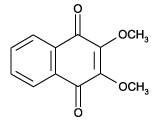Redox-cycling agent that induces intracellular superoxide anion formation and, depending on the concentration, induces cell proliferation, apoptosis or necrosis. DMNQ does not react with free thiol groups, is non-alkylating and adduct-forming in contrast to other quinones. Thus, DMNQ is a valuable tool for the generation of reactive oxygen species (ROS) in order to study the role of ROS in cell toxicity, apoptosis and necrosis.
Product Details
| Alternative Name: | 2,3-Dimethoxy-1,4-naphthoquinone |
| |
| Formula: | C12H10O4 |
| |
| MW: | 218.2 |
| |
| CAS: | 6956-96-3 |
| |
| Purity: | ≥99% (TLC) |
| |
| Identity: | Determined by NMR. |
| |
| Appearance: | Yellow crystalline solid. |
| |
| Solubility: | Soluble in acetone, DMSO or methanol. |
| |
| Shipping: | Ambient Temperature |
| |
| Long Term Storage: | -20°C |
| |
| Handling: | Protect from light. |
| |
| Regulatory Status: | RUO - Research Use Only |
| |
Please mouse over
Product Literature References
Iron deficiency aggravates DMNQ-induced cytotoxicity via redox cycling in kidney-derived cells: D. Yoshihara, et al.; Free Radic. Res.
56, 544 (2022),
Abstract;
A CRISPR screen identifies a pathway required for paraquat-induced cell death: C.R. Reczek, et al.; Nat. Chem. Biol.
13, 1274 (2017),
Abstract;
Full Text
The Bioenergetic Health Index is a Sensitive Measure of Oxidative Stress in Human Monocytes: B.K. Chacko, et al. ; Redox Biol.
8, 43 (2015),
Application(s): Inhibited mitochondrial function in human monocytes,
Abstract;
Oxidative stress promotes polarization of human T cell differentiation toward a T helper 2 phenotype: M.R. King, et al.; J. Immunol.
176, 2765 (2006),
Abstract;
Full Text
Potentiation of nitric oxide synthase expression by superoxide in interleukin 1 beta-stimulated rat mesangial cells: K.F. Beck, et al.; FEBS Lett.
435, 35 (1998),
Abstract;
The relative importance of oxidative stress versus arylation in the mechanism of quinone-induced cytotoxicity to platelets: S.A. Seung, et al.; Chem. Biol. Interact.
113, 133 (1998),
Abstract;
DNA single-strand breakage in mammalian cells induced by redox cycling quinones in the absence of oxidative stress: W.A. Morgan; J. Biochem. Toxicol.
10, 227 (1995),
Abstract;
Different prooxidant levels stimulate growth, trigger apoptosis, or produce necrosis of insulin-secreting RINm5F cells: J.M. Dypbukt, et al.; J. Biol. Chem.
269, 30553 (1994),
Abstract;
Full Text












